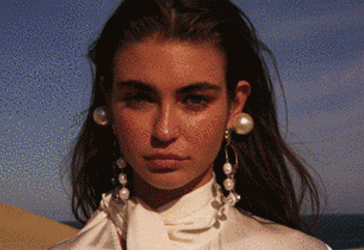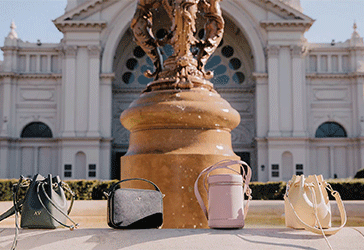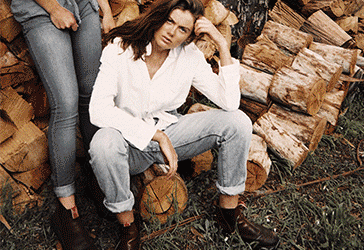The fearless, the failures and the future with celebrity stylist Lana Wilkinson.
“Your child will see this one day!” “OMG put it away.” “Use your brain instead.” “Nice legs ;)”
Though these read like comments from the social media launch of Kim Kardashian’s infamous Paper Magazine cover, they could just as easily be applied to one Jean Shrimpton, who broke the internet before it even existed.
Often touted as the most beautiful girl in the world, our little minx Jean was one of the highest paid supermodels of her time and an icon of the sixties in Swinging London. Jean was brought to Australia to judge the 1965 Fashions on the Field contest over the four-day Spring racing carnival to promote a new acrylic fabric called Orlon by DuPont de Nemours International. Using the Orlon fabric sent by DuPont, London dressmaker Colin Rolfe designed a wardrobe for her visit with Jean’s input.
Derby Day arrived and the crowd eagerly anticipated the star’s arrival. And there she was. A white shift dress 13cm above her knee. The crowd was shaken and stirred. Women in fox stoles were baffled, but the men were likely quite pleased. But Jean’s scandalous ensemble was worsened by her lack of gloves, stockings or hat. No. Hat. And she wore a man’s watch; how dare she?
Newspapers around the nation echoed Flemington’s feelings, though it was too late. The mini skirt was born. Jean was elegant, confident and carefree and the youth of Australia lapped it up. It wasn’t about fame, for Jean had bountiful acclaim – she was just a sixties goddess getting it done.
Taking a step back in time, celebrity stylist Lana Wilkinson remembers dress codes were not obligatory. Social media hadn’t reinforced the black and white theme for Derby Day and everyone was wearing colour. “I wore pink to Derby Day,” Lana said. “It was an amazing outfit,” she said. “However, I would say to my younger self ‘Obey the dress codes,’ as you want to be able to look back at an image and look timeless.”
Racing fashion can essentially be documented in two periods, before Jean and after Jean. In approximately 60 years BJ (before Jean) tussore coats and cloche hats were big. The world was at war, but the races went on. Hemlines graced the calf in the 1940s, and as the fifties dawned a few informed women endorsed Dior’s move to lift hemlines just below the knee.
However, we no longer solely rely on a monthly subscription to arrive and tell us what to wear. Lana believes women elevated their fashion for racing events in the mid 1900s, but currently we have the best access to incredible racing style inspiration.
“With the internet and in particular social media, more awareness of race wear, fashion, designers, milliners, hair and makeup artists and styles is more prevalent and accessible than ever before,” Lana said. “It has become a staple in the fashion calendar for sure and racing fashion has evolved as a result.”
After the media storm that was Jean on Derby Day, the mod sixties look we love today were heavily replicated in 1 AJ (after Jean), then the seventies saw a move to flowing maxi-dresses and wide-brimmed hats, with the occasional flair and crochet popping up as structure took some time to recuperate before it would be exhausted in the eighties.
There were puffy sleeves, shoulder pads, striking colours and a going notion of androgyny. Nobody did 85 AJ better than the Princess of Wales herself; Diana sported a black and white suit by Bruce Oldfield with bold millinery by Frederick Fox, throwing unintentional shade at everyone who dared to wear taffeta.
Then it was 90 AJ and the big hats kept their place at racing clubs around the country, complimented by fitted suits and an acidic colour palette. Despite believing the best racing fashion era is still yet to reveal itself, Lana loves the eighties and nineties as she believes that was when fashion became a hero.
The same year The OC blessed our screens with the skin-sensational looks of the 2000s, the two-piece took its turn at the track. Let us not forget the Hilton sisters in 2003; Lana Wilkinson wonders if looks like theirs will ever make a comeback.
“Everything becomes chic again, but I hope large bare midriffs and cut-outs never make a comeback, case in point the Hilton sisters when they visited Flemington for the Spring Racing Carnival,” Lana said. “Paris and Nicky’s looks were acceptable at the time, but I hope they never see the light of day on a racecourse again,” she said. “I do remember at the time thinking they look hot, so who knows!”
Known for dressing some of the most glamorous women for racing carnivals, Lana’s favourite looks from recent years includes Elyse Knowles in a custom Cappellazzo Couture dress, Kim Wiebenga Millinery and Aquazzura shoes on Melbourne Cup Day 2017.
“She’d just come off the TV Series THE BLOCK and people were used to seeing her in overalls,” Lana said. “The colour was strong, but I recall her being swarmed by paparazzi and it was on everyone’s best dressed list,” she said.
“My other absolute favourite, and it is mentioned as an all-time best raceway look, would be Rebeeca Judd in an Alex Perry dress, The Hatmaker Crown by Jonathan Howard and Dolci Firme heels, 2015 Cup Day.”
Looking at the history of race wear, Lana thinks the best moments occur when you fuse respect for tradition with your personal aesthetic. “Most importantly, when you look at the history of fashion, the big winners look happy and confident in their own skin,” she said. “Dress so you feel like your untouchable!”
However, unless you’re Jean Shrimpton, you can leave your hat on.
For your trackside fashion fix, see Lana Wilkinson’s Style Guide for the First-Time Racegoer here.










